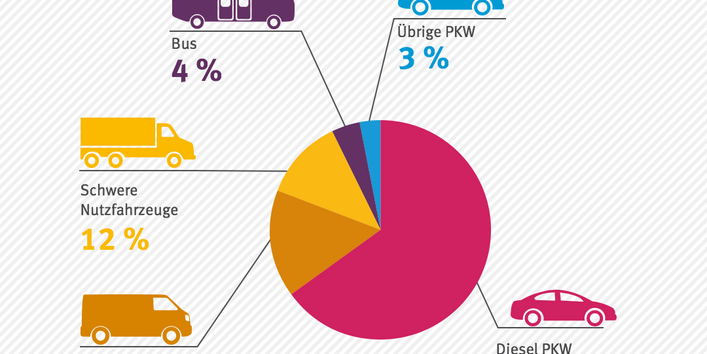Air in cities becoming cleaner: number of cities above NO2 limit down by half in 2019
The German Environment Agency has published the final data for 2019 on nitrogen dioxide (NO2). The data show that only 25 cities exceeded the annual mean NO2 limit value of 40 micrograms NO2 per cubic metre of air (µg/m³), compared to 57 cities in the previous year. Preliminary data for 2020 already points to further reductions of NO2 pollution by up to 40 percent in the wake of the coronavirus pandemic. It remains to be seen how overall air quality will improve in 2020.
Federal Environment Minister Svenja Schulze said: "The air in German cities is becoming cleaner, and the development of air quality nationwide is pointing in the right direction. This shows that environmental policy is effective. Nevertheless, the measures taken so far by the federal government, the federal states and the local authorities are not yet sufficient to ensure that the EU limit value for NO2 for the protection of human health is really complied with throughout Germany. The solution lies in cleaner vehicles and a fundamental change in mobility."
The main source of nitrogen oxides in cities is road traffic, and mainly from diesel passenger cars. Exceedances of the NO2 annual average limit value occur exclusively on busy roads in conurbations and cities. In 2019, NO2 concentrations exceeded the limit value of 40 µg/m³ as an annual average at 20 percent of all measuring stations close to traffic. In 2018, 42 percent of the stations exceeded the limit, more than twice as many as in the previous year. The limit value set for the protection of human health should already have been complied with since 2010.
Overall, NO2 pollution in cities clearly continues to decline. On average, the NO2 values (annual mean values) at measuring stations close to traffic were about four micrograms per cubic metre below those of 2018. The amount of the decreases varies depending on the individual measuring stations. Reasons for the decrease include local measures such as speed limits, driving bans or the use of low-emissions buses, nationwide measures such as software updates, subsidies as part of the "Clean Air 2017-2020" immediate action programme, as well as the renewal of the vehicle fleet with vehicles that also have low nitrogen oxide emissions in real operation, and meteorological influences that influence the spread of air pollutants.
Dirk Messner, President of the German Environment Agency (UBA), said: "If the above measures remain in place, we can expect a further decline in NO2 pollution in 2020 and the number of exceedances in the cities concerned to decline, too."
The coronavirus pandemic will prove to play a part in cutting NO2 pollution. During the period of nationwide pandemic-related restrictions, NO2 concentrations decreased by between 15 to 40 percent. It is not yet clear what effect this reduction will have on compliance with the NO2 annual mean limit value for 2020. The 30-50% reduction of nitrogen emissions due to less road traffic in cities, which was triggered by the comprehensive restrictions on public life to cope with the pandemic, was only a short-term effect of about four weeks. This will have a proportionate effect only on the year as a whole.
Dirk Messner said: "It has taken the coronavirus crisis to make us realise that less traffic means better air and less noise, and therefore higher quality of life in our cities. We ought to take this positive outcome of the crisis as a further incentive to achieve a sustainable transformation in mobility. For the sake of protecting human health, we need a lasting and sustainable improvement to air quality by means of targeted air pollution control measures."
Note on the data: The data for monitoring air quality in accordance with the requirements of the EU Directive are collected by the measuring networks of the federal states (Länder). Subsequent data deliveries or corrections from the state monitoring networks are accepted until the date of the official report to the EU Commission on 30 September 2020.





